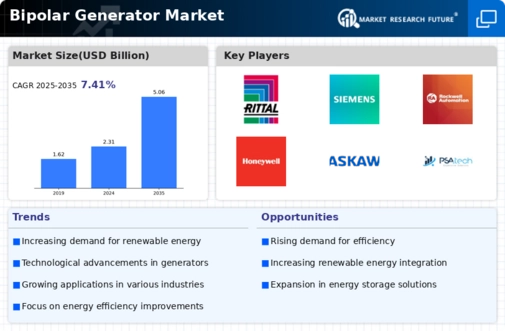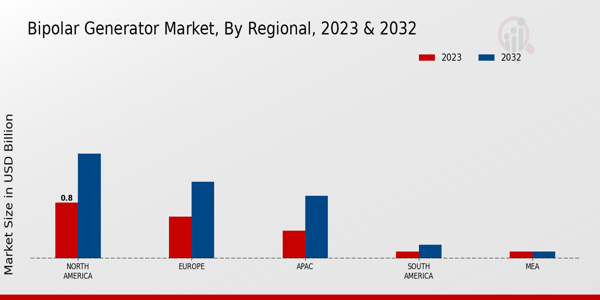Market Growth Projections
The Global Bipolar Generator Market Industry is projected to experience substantial growth in the coming years. With a market value anticipated to reach 2.31 USD Billion in 2024 and further expand to 5.06 USD Billion by 2035, the industry is poised for a robust trajectory. This growth is underpinned by a compound annual growth rate of 7.39% from 2025 to 2035. The increasing demand for efficient energy solutions, coupled with technological advancements and supportive government policies, is likely to drive this upward trend. As industries and consumers alike seek sustainable energy options, the bipolar generator market is expected to flourish.
Growing Industrial Applications
The Global Bipolar Generator Market Industry is witnessing a surge in industrial applications, particularly in sectors such as manufacturing and telecommunications. Bipolar generators are increasingly utilized for their reliability and efficiency in powering critical infrastructure. Industries are recognizing the benefits of these generators in ensuring uninterrupted power supply, which is vital for operational continuity. For instance, manufacturing plants are adopting bipolar generators to support their energy needs, thereby reducing downtime and enhancing productivity. This growing reliance on bipolar generators in industrial settings is expected to significantly contribute to the market's expansion, with a projected value of 5.06 USD Billion by 2035.
Government Initiatives and Incentives
Government initiatives and incentives play a crucial role in shaping the Global Bipolar Generator Market Industry. Many countries are offering financial incentives and subsidies to encourage the adoption of energy-efficient technologies, including bipolar generators. These initiatives aim to promote sustainable energy practices and reduce reliance on fossil fuels. For example, the United States has implemented tax credits for businesses that invest in renewable energy technologies, which often include bipolar generators. Such supportive policies are likely to accelerate market growth, as they lower the financial barriers for businesses seeking to transition to cleaner energy solutions.
Environmental Regulations and Compliance
Increasing environmental regulations are influencing the Global Bipolar Generator Market Industry significantly. Stricter compliance requirements regarding emissions and energy efficiency are prompting industries to adopt cleaner technologies. Bipolar generators, with their lower environmental impact compared to traditional generators, are becoming a preferred choice for companies aiming to meet regulatory standards. For instance, the European Union has set ambitious targets for reducing greenhouse gas emissions, driving demand for cleaner energy solutions. As industries strive to comply with these regulations, the adoption of bipolar generators is expected to rise, further propelling market growth.
Rising Demand for Renewable Energy Solutions
The Global Bipolar Generator Market Industry is experiencing heightened demand due to the increasing emphasis on renewable energy solutions. Governments worldwide are implementing policies to reduce carbon emissions, thereby promoting the adoption of clean energy technologies. Bipolar generators, known for their efficiency in energy conversion, are becoming integral to renewable energy systems. For instance, countries like Germany and China are investing heavily in wind and solar energy, which often utilize bipolar generators for optimal performance. This trend is expected to contribute to the market's growth, with projections indicating a market value of 2.31 USD Billion in 2024.
Technological Advancements in Generator Design
Technological innovations are driving the Global Bipolar Generator Market Industry forward. Recent advancements in generator design, such as improved materials and enhanced efficiency, are making bipolar generators more attractive for various applications. These innovations not only increase the lifespan of generators but also reduce operational costs. For example, the integration of smart technology allows for real-time monitoring and optimization of energy output. As industries seek to enhance productivity while minimizing costs, the adoption of advanced bipolar generators is likely to rise. This trend is anticipated to support a compound annual growth rate of 7.39% from 2025 to 2035.























